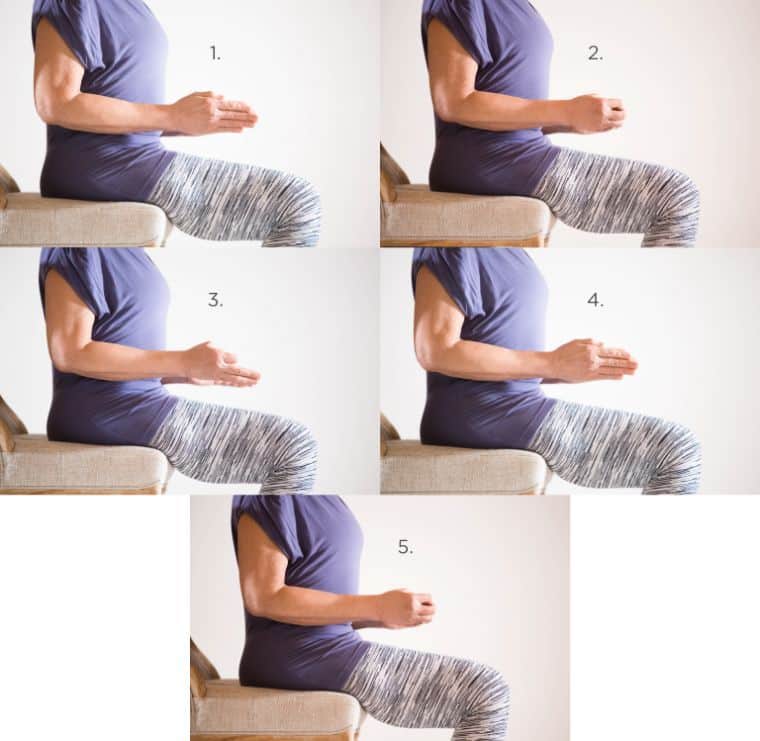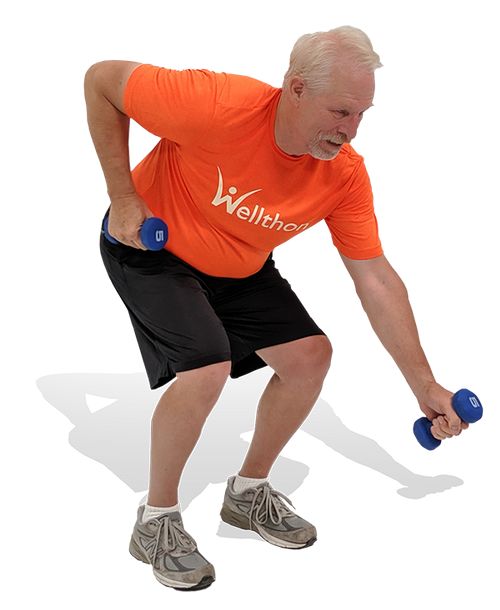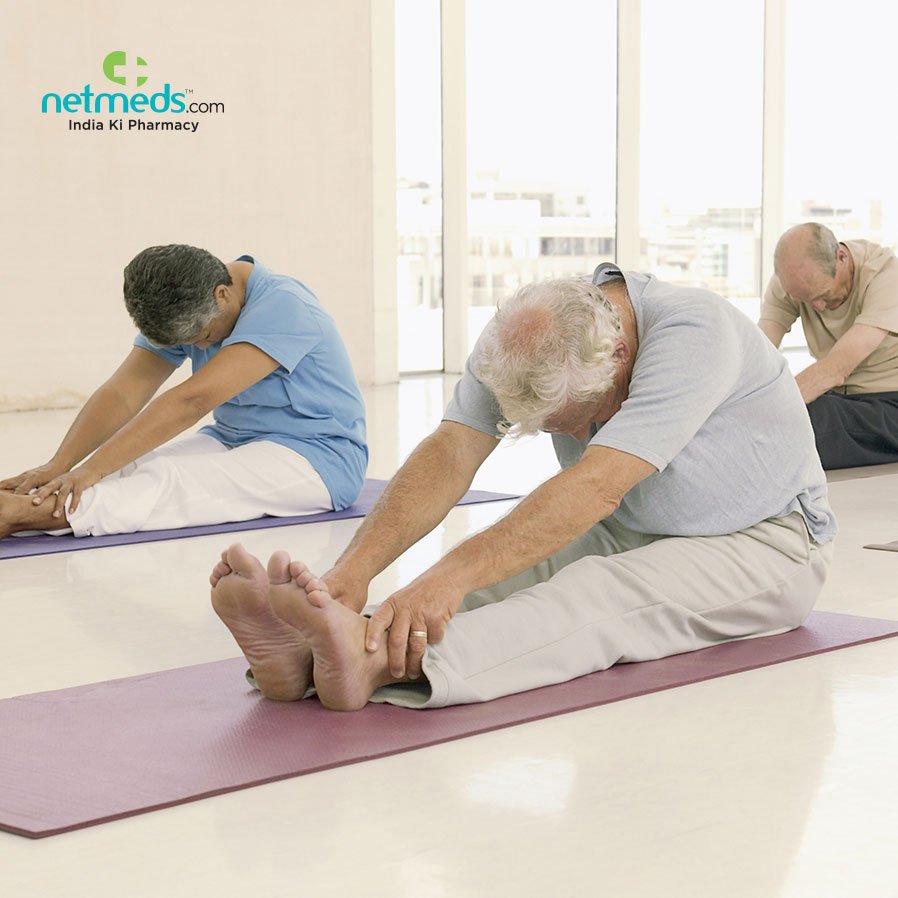Build A Support System
Support comes in many different forms. Family caregivers, friends, physical therapists, fitness coaches and peers who are also living with Parkinsons can all play a vital role in keeping a PD patient motivated and active. Working out with a partner or a group provides valuable social interaction and tends to encourage consistency and commitment.
PD-specific group exercise programs like Dance for PD and Rock Steady Boxing are offered through a sizeable network of partners and affiliates to help patients stay active, socialize and manage their symptoms.
When confidence in mobility and functionality are lost, seniors with PD gradually begin moving less, avoid leaving the house or even cease caring for themselves. While this behavior is understandable, a sedentary lifestyle will lead to more severe stiffness, rigidity and depression. Being still only exacerbates symptoms, lessens quality of life and speeds up progression of the disease. There is no one best exercise or physical therapy plan for Parkinsonsonly what works best for each patient.
Brian Grant Foundation Exercise Videos
Cost: Free
Cost: Free for 9 videos $29/month or $290/year for online streaming
The nine free classes include boxing fundamentals, HIIT , chair fit, tai chi, core, yoga, stretching/mobility. The free classes are 13 to 30 minutes. Classes are led by a physical therapist with Parkinsons specific certifications.
Paid classes incorporate PWR! Moves, cognitive dual task training, balance training, intensity training, and flexibility. For subscribers, new 20-25 minute videos are released weekly.
Cost: Free
Dance exercise class videos on YouTube. Each is fewer than 10 minutes long. Nearly 30 videos as of October 28, 2020.
Rachelle was featured at the Davis Phinney Foundation Victory Summit Albany in October, 2020. Watch an interview with Rachelle here, and Rachelle’s 25 minute Dance Beyond Parkinson’s Summit presentation here.
Cost: Free
Six seated dance exercise class videos on YouTube. Each is about one hour long. All are with the same instructor.
Cost: Free for 16 videos $50 for 100+ videos
Sixteen archived exercise classes are available for free viewing. Classes are designed to increase coordination, balance, flexibility, and strength through music and movement from a broad range of dance styles. 100+ archived classes and additional benefits are available for a $50 membership.
Best Physical And Occupational Therapy Exercises
Physical therapy exercises target your areas of concern. They can help develop your strength, balance, and coordination. Youll also enhance your functional mobility by improving concentration, flexibility, and range of motion.
Occupational therapy exercises are intended to help you perform daily activities related to work, school, or home with greater ease.
Read Also: Can Botox Cause Parkinson’s
Parkinson’s On The Move
Cost: Free
Thirty-one archived workouts for those with Parkinson’s. Videos are sortable by level of difficulty, area of the body to focus on, and preferred position . Other pages on this website offer free recipes and articles about nutrition and PD.
Also available is the Parkinson’s On The Move Exercise Library. This collection of 58 short videos each focus on stretching or strengthening a specific part of the body.
Cost: Free
Suzanne Chen leads 43-minutes of stretch and strengthening exercises for those with Parkinson’s. Equipment to follow along include an elastic band, light weights , a 8-9 inch soft ball , and a stable chair with no arms.
Cost: Free
Eight YouTube exercise videos for those with Parkinson’s, including four focused on neuromuscular integration, two total body conditioning and one seated strength. Most videos are about 30 to 45 minutes.
Cost: Free
Similar to Rock Steady Boxing in the US, this Australian app is available from Google play or the App Store is designed for early stage Parkinson’s disease. It includes 10 PD Warrior core exercises for free with upgrades and additional bundles available via in app purchases to customize your workout. Each exercise is demonstrated by a physiotherapist.
Cost: Free
Recordings of nearly 30 exercise classes that include a warm up, low/medium/high intensity exercises, boxing, dance, and cool down. There are also recordings of choir for PD classes and communications classes.
Cost: Free
Cost: Free
Cost: $25.95
How Often Should You Exercise

The Parkinsons Foundation recommends that people with the disease complete moderate to vigorous aerobic exercise at least three times per week for 30 minutes. Strength training, stretching, and balance exercises should be done two to three times a week. 150 minutes of active exercise a week is suggested.
Read Also: End-stage Parkinson Disease Life Expectancy
Fitness Tips To Manage Pd Symptoms
- Choose an exercise program that you will actually do! Dont design a great, Parkinsons-specific program and then skip it because its too hard or not fun.
- Follow a varied routine. Perform simple stretches and posture exercises daily, and make sure to include aerobic and strengthening exercises several times per week.
- Keep intensity at a level that feels somewhat hard for you.
- Consider joining an exercise class or group. Classes are good motivation and also provide an opportunity to socialize. Trained instructors give clear guidelines and offer modifications.
- Try exercise videos or home exercise equipment if it is difficult to get out.
- Music can enhance performance by providing rhythm to coordinate movement.
- Be creative with your fitness. Challenge yourself and have fun!
- Consider attending Moving Day, a Walk for Parkinsons, in your area to keep moving and strengthen your PD fitness community.
Sponsored by Kyowa Kirin. Content created independently by the Parkinsons Foundation.
For more insights on this topic, listen to our podcast episode Benefits of Practicing Tai Chi Chuan Exercises.
Exercise : Side Leg Raise
STARTING POSITION: Lying on your side. The leg closest to the floor is bent, and the top leg is straight. Cradle your head with your arm, or use a pillow for neck support.
Repeat 20 times per leg.Rest and perform a second set before switching to the other side.
Bad Form Alert!
Its very easy to do this exercise incorrectly. When done correctly, you should feel muscles in the back of your hip working. You should NOT feel it in the front of your hip. If you do, youre using your hip flexor or TFL muscles.
DONT:
- Let your hips fall backward. Keep them stacked by actively leaning forward.
- Let your leg kick in front of you. Raise it straight up as if youre sliding your heel along an invisible wall behind you.
- Let your toes point up. Keep your foot parallel to the floor, or even point the toes slightly down to the floor if possible.
Also Check: Where Does Parkinson Come From
Live Large With Parkinson’s At The Countryside Y
Cost: Free
These two 25-minute exercise classes are designed for people with Parkinson’s. The exercises may be done seated or standing, supported by a chair. These videos were created in March/April 2020.
Purchase Info: www.lsvtglobal.com or email
Cost: $28 for DVD or download $15/year streaming
Videos are designed for people with PD to use as an adjunct to LSVT BIG treatment delivered by an LSVT BIG certified clinician. The videos can also be used during the month of therapy and after therapy as a motivation to practice and keep moving. Volume 1 contains standard exercises while standing. Volume 2 contains exercises adapted to seated and supine positions, plus a chapter for caregivers. Available in English, German and Japanese.
Purchase Info: Ohana Pacific Rehab Services, 808-262-1118, online
Cost: $24.50 for DVD $19.50 for book $40 for DVD and book
This program focuses on exercises, flexibility, and pragmatic solutions for walking, moving, falling, and getting up off the floor. Adaptive equipment is reviewed. Demonstrators have PD. Three levels of exercise shown. Designed by a physical therapist.
Brisk Walking Or Jogging
Aerobic exercise on a treadmill or on a sidewalk improves cardiovascular fitness.
- You could still have a conversation if you start walking or jogging at a pace where you feel your heart rate increase.
- As you move, try to focus on taking larger steps. People with Parkinson disease may benefit from listening to a metronome app.
- Take a rest when you feel tired. Try to increase your walking or jogging sessions to 30 minutes at least three times a week.
Read Also: Estrogen And Parkinson’s Disease
Conductorcise Exercise For Cognitive Stimulation
Another form of movement that involves cognitive function is Conductorcise®, created by long-term conductor David Dworkin, which works out the upper body, is low impact and doesnt require much skill, making it easy for people who are older, overweight or chair bound. The goal is for participants to feel the beat and wave their arms to the music. Conductors have to remember several hundred parts to conduct an orchestra. Theyre constantly moving theyre standing up theyre dancing. They get a tremendous amount of physical and mental exercise simultaneously. Maestros also claim that conducting is a spiritual experience. Did you know that orchestra conductors live longer than nearly any other group of people?
But you dont have to take a Conductorcise class to get into the swing of things. Just turn on the music, grab a baton , and start moving!
Check out these cognitive stimulation activities from NeuroUP, to enhance cognitive functions frequently affected in people with Parkinsons disease: attention, visuospatial skills, information processing, and executive function.
How To Develop A Parkinsons Exercise Program
The Parkinsons Foundation recommends intense exercise as often as possible for those who have been diagnosed with PD and to people who are concerned about developing PD due to their family medical history. However, every patient is different and each experience with Parkinsons is unique. When developing a fitness plan for Parkinsons, its important to consider a seniors abilities, limitations, PD symptoms, overall health, resources and energy level.
Don’t Miss: What Is Parkinson’s Law
Exercise Progression And Compliance
Rate of Perceived Exertion was collected after each session on ascale of 0-10. All scores were averaged over the course of the study.Progression level was determined by the physical therapist and recorded by theparticipants. For those exercising at home, the level of exercise was determinedin the beginning and held constant. For those in the group and individualexercise, the level of exercise could change over time, based on the physicaltherapist’s observations. Compliance was calculated by percentage of assignedexercise sessions in which exercise occurred.
Pathophysiology Of Parkinsons Disease

The progressive death of dopaminergic neurons in the Substantia Nigra pars compacta located in the midbrain, more precisely in the Basal Ganglia , promotes a significant decrease in the levels of the neurotransmitter dopamine, and as a consequence the functional impairment of the neural circuits . The chronic reduction in dopamine levels gives rise to the manifestation of the motor symptoms that characterize this disease. However, the pathophysiology of PD is not limited to the dopaminergic system, that is, neuronal degeneration of other areas of the brain such as the brainstem and cortex competes and even precedes neuronal death in BG. Thus, other neurotransmitter systems are compromised, thus making PD a multisystemic pathology manifested by a series of motor and non-motor symptoms .
Examples of experimental tests showing a high and a low data dispersion.
The cardinal motor signs of PD are: resting tremor, plastic-type muscular rigidity, bradykinesia , and postural instability. This set of symptoms associated or not, forges characteristic clinical signs in patients with the disease such as gait and balance disorders, mask facies and dysarthria. In addition to these symptoms, a set of sensory autonomic and cognitive-behavioral symptoms may manifest during the course of the disease .
Read Also: Parkinsons Staring Into Space
Recommended Reading: How To Get Diagnosed With Parkinson’s
What Types Of Exercise Are Best For People With Parkinsons Disease
In last weeks blog, we addressed the reasons why it is vital for people with Parkinsons disease to exercise, including improving particular motor and non-motor symptoms such as impaired balance, gait disorders, depression, and cognition.
Today, we will tackle another important question what types of exercise are most beneficial to help people with Parkinsons disease improve their quality of life? Well also address several specific types of exercise designed for people with PD and some tips on how to get started with an exercise program.
Neuroprotective Benefits Of Exercise
Neuroprotection is when your brain works to prevent the death of neurons, or brain cells. For people with PD, exercise is not only vital to maintaining balance, mobility and daily living activities, but it has the potential to have a neuroprotective effect.
The Parkinsons Foundation studied exercise as part of our Parkinson’s Outcomes Project study. Our Center of Excellence network believes that exercise is important to good outcomes in PD, and data supports that. Exercising enhances the sense of wellbeing, even across different disease stages and severities.
Also Check: How To Get Parkinson’s
What Type Of Exercise Should I Do If I Have Parkinson’s Disease
Exercise is a planned, structured, repetitive activity that is intended to improve physical fitness. There is no right exercise for people with Parkinsons. Everyones regimen will differ, depending on overall health, symptoms and previous level of activity. Any exercise helps, and a variety of exercise types may provide well-rounded benefits.
Aerobic exercise
Aerobic exercise involves activities that challenge your cardiorespiratory system such as walking, biking, running, and activities in the pool. Participating in aerobic exercise at least three days a week for 30-40 minutes may slow Parkinsons decline.
Strength training
Strength training involves using your body weight or other tools to build muscle mass and strength. Strength training two days per week, starting with low repetition and weight, may be beneficial in Parkinsons disease. A focus on extensor muscles, or muscles in the back of the body, can help with posture.
Flexibility training
Stretching two or more days per week can be beneficial to maintain range of motion and posture. Holding each stretch of major muscle groups for 30 to 60 seconds can improve muscle length.
Balance and agility training
This type of training often combines aerobic exercise, strength training, and flexibility training. Examples include:
- Tai chi, yoga or Pilates.
Parkinson’s Disease And Movement Disorders Center
Our center provides compassionate and timely treatment to patients with movement disorders, such as dystonia, ataxia, essential tremor and similar conditions. But our mission goes beyond patient care excellence. By offering educational events and support groups, we empower patients and caregivers to become better partners in their health.
Recommended Reading: Big Exercise Program For Parkinson’s
How To Exercise With Parkinsons
Whether you’re a first-time exerciser or a lifelong athlete, the key to working out with Parkinsons is to safely and regularly move your body in a variety of ways. Your fitness regimen should include these four main categories of exercise:
- Aerobic activity
- Balance, agility, and multi-task exercises
People with Parkinsons should strive to perform aerobic activity at least three times weekly and to complete exercises from the other categories two to three times each week.
In total, the Parkinsons Foundation suggests performing 150 minutes of moderate tovigorous exercise weekly.
To help you achieve this goal, try these helpful tips:
- Invest in a treadmill, elliptical, or exercise bike. This will make it convenient to perform aerobic exercise from your home, regardless of the weather.
- Obtain a set of light hand weights from a local exercise shop or thrift store. These can be used for a wide variety of strength training exercises.
- Follow along with one of the many online exercise classes on YouTube that are tailored to people with Parkinsons disease. The Parkinsons Foundation and the Davis Phinney Foundation offer many great online exercise videos.
- Connect with a workout buddy by finding a local Parkinsons support group associated with the American Parkinson Disease Association
Davis Phinney And Kelsey Phinney Practice Vocal Exercises For Parkinsons
In this 23-minute episode of The Parkinsons Podcast, Davis Phinney and his daughter and podcast host, Kelsey Phinney, practice and explain some vocal warmup exercises before Davis sings a few pop songs. Daviss voice gets louder and clearer over the course of the session and is a good demonstration of the benefit of speech therapy and daily practice of speech exercises, including singing, for those with Parkinsons.
You May Like: What Are The Long Term Effects Of Parkinson Disease
Parkinsons Disease: Background Info
Parkinsons disease usually occurs spontaneously and is of unknown origin. About one million Americans live with Parkinsons disease. Worldwide there are 10 million people living with Parkinsons disease. The average age of diagnosis of those with Parkinsons disease is 60 years, and the disease gradually progresses during the next 10 to 25 years after diagnosis.
In the brain, nerve cells use dopamine to control muscle movements. In people with Parkinsons disease, the brain cells making dopamine gradually die. Over time, it becomes harder for people with Parkinsons disease to move their muscles.
The following are some symptoms of Parkinsons disease:
- Pill-rolling tremor of the hands at rest
- Sleep disturbances
The diagnosis of Parkinsons disease is based on history and physical examination findings. Importantly, neuroimaging, EEG, and spinal fluid studies are usually within normal limits for age in those with Parkinsons disease.
Unfortunately, there is no cure for Parkinsons disease. Certain drugs such as carbidopa-levodopa and MAO-B inhibitors can be used to substitute or increase dopamine levels in the brain. These dopaminergic drugs, however, lose efficacy over time and have negative side effects.
Parkinsons disease is also treated symptomatically with drugs that help with mood disturbances, pain complaints, and sleep problems.
Parkinsons Home Exercise Program

You dont need to join a gym or purchase expensive fitness equipment to stay active with Parkinsons disease. On the contrary, there are many great exercises that you can do from the comfort of your home, regardless of which stage of the disease you are in. Take a look at some great examples in the sections below.
Recommended Reading: What Is Dystonia In Parkinson’s Disease
